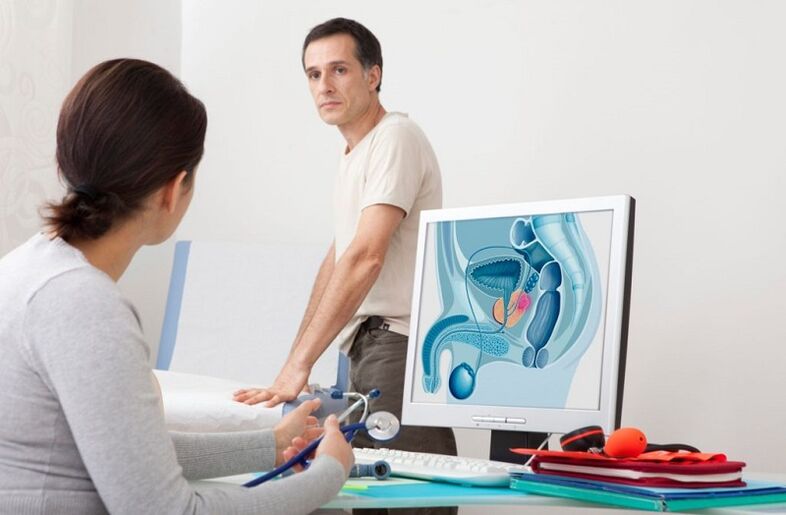Acute prostatitis is an infectious and inflammatory disease that covers the tissues of the prostate, causing severe swelling and the appearance of purulent foci. The disease can manifest itself in different ways, depending on the stage of its development. Therefore, an integrated approach is needed for its accurate diagnosis. Treatment of acute prostatitis is most often based on medication and physiotherapy techniques.
The reasons
<1_img_centerxx>Alcoholism can cause acute prostatitis.
The disease most often develops in men over 30 years old. In most cases, the disease develops due to the negative impact of pathogenic microflora on the male body. Thus, acute prostatitis in humans can be triggered by the activity of the following microorganisms:
- Staphylococcus aureus;
- Pseudomonas aeruginosa and Escherichia coli;
- klebsiella;
- enterococcus;
- Proteus.
Most of the above microorganisms are constantly in the human body, while no inflammation is observed. If such bacteria enter the tissues of the prostate, the process of their active reproduction begins, as a result of which severe inflammation develops in the prostate.
The penetration of bacteria into the genitourinary system can occur during unprotected sex. Therefore, it is very important that people who do not have regular sex partners use condoms.
Inflammation can also be non-infectious in nature and develop for the following reasons:
- obesity;
- sedentary lifestyle;
- rare sexual intercourse;
- severe hypothermia;
- interruption of sexual intercourse;
- eating disorders;
- smoking and alcohol abuse.
The above factors create a fertile ground for the stagnation of the secretion of the prostate. At the same time, stagnant blood processes are noted in the vessels located in the immediate vicinity of the organ.
With a large accumulation of prostatic secretions, a favorable environment is created for the reproduction of pathogenic microflora. As a result, the development of the inflammatory process occurs. The latter is likely to cause a number of complications, such as:
- HBP;
- abscess;
- oncological process.
Important!Against the background of acute prostatitis, most men develop problems with potency, and there is a risk of infertility.
Thus, in the risk group for the development of this disease are people who:
- there is no regular sex life;
- there is a lack of physical activity;
- there are bad habits.
Forms and stages

For any symptoms of prostate discomfort, you should immediately go to the hospital.
In modern medicine, there are three main stages of this disease. Let's take a look at them in more detail:
- The first stage is called catarrhal.It is characterized by the appearance of a primary inflammatory process with the appearance of edema of the glandular tissue, expansion of acini. In this case, the prostate increases in size. If the disease is left untreated, the inflammation gradually passes to the excretory ducts of the prostate glands, which are connected to the posterior part of the urethra. With inflammation of the ducts of the prostate, their gradual narrowing and blocking occurs, which makes the process of secretion of secretion from the prostate somewhat difficult. At the catarrhal stage of its development, the inflammatory process covers only the mucous layers.
- Next comes the follicular stage of the disease.It is characterized by the continued progression of the inflammatory process, in which the remaining tissues of the organ are gradually involved. As a result, an acute form of bacterial prostatitis develops. In the analysis of urine at this stage of the development of the disease, pus is present. However, despite damage to a significant number of tissues, the follicular form of prostatitis responds well to treatment.
- The last stage is called the parenchymal.It is characterized by a destructive change in the tissues of the prostate. At the same time, the swelling gradually increases, and the inflammatory process eventually covers the entire organ. If the development of the disease reaches this stage, then the treatment process is very complicated, requiring radical measures. In the absence of timely and adequate treatment, chronic prostatitis can develop.
At the initial stage of development of this disease, a subacute stage is usually distinguished. It is characterized by low severity of signs, which is explained by the low activity of pathogens. The disease can be at this stage for a long time if the patient's body has good resistance. At the same time, it is very difficult to diagnose the disease in the subacute stage, which is why most patients do not receive timely treatment.
Symptoms
Each of the forms of this disease is characterized by its own symptoms. Therefore, you have to consider them separately.
Catarrhal form

This form of the disease is characterized by frequent urges to walk with little need.
If the infection has reached the excretory ducts, this stage of the disease develops. But despite the fact that the inflammatory process does not go beyond the mucous membrane, the prostate increases in size and swells. In this case, the urethra is compressed.
Symptoms of acute prostatitis at this stage are mild:
- due to the compression of the canal, the patient may notice minor problems with urination;
- at night, the urge to urinate becomes more frequent;
- possibly an increase in body temperature up to 38 degrees;
- when the patient is in a seated position, he may feel a certain heaviness in the perineum.
In some cases, the catarrhal form occurs without severe hyperthermia.
Symptoms of the disease may go away on their own after a few weeks after development. And most of the patients in this case do not go to the doctor. However, this is fraught with the transition of the disease to a chronic condition. Provided that the treatment of acute prostatitis is started in a timely manner, the disease regresses after 10 days.
Follicular form
If the catarrhal stage has not been treated, the disease develops further, affecting the individual lobes of the organ. In this case, pronounced symptoms appear:
- sharp pain observed during urination;
- the patient's body temperature is kept at about 38 degrees;
- dull pain appears in the perineum, which radiates to the penis;
- the process of urination is complicated;
- the patient has difficulty defecating due to the presence of severe pain.
As this stage is characterized by a purulent lesion of the prostate, streaks of pus can be observed in the patient's urine. Provided that the treatment is carried out in a timely manner, a complete cure of the disease at this stage occurs within two weeks after the start of the procedures.
Parenchymal form
It is also called diffuse. Since the inflammatory process covers the entire organ, the following symptoms appear:
- Perineal pain becomes almost unbearable. Periodically, they move to the glans penis. Some pain relief is possible when lying down, when the patient rests both legs against the chest.
- Sensation of a foreign body in the rectum. There is severe pain in the stool. Constipation becomes more common, and if the inflammatory process turns into a reactive form, the secretion of mucus begins from the anus.
- Serious urination problems appear. In this case, partial and complete urinary retention is possible.
- Body temperature can reach 40 degrees. The patient suffers from chills.
Diagnostic

To make a definitive diagnosis, a number of different studies will be needed.
This disease is diagnosed by a specialist urologist who conducts a comprehensive study involving the following types of procedures:
- physical examination;
- instrumental research;
- laboratory research.
During the initial examination of the patient, the specialist palpates the gland. This should be done very carefully, avoiding massaging movements and strong pressure. Otherwise, you can cause significant discomfort for the patient.
The main method of diagnosis is the study of the prostate, carried out by inserting a probe into the rectum. This procedure allows specialists to obtain the following data:
- determine the response to pain;
- identify the main sources of destruction;
- confirm or deny signs of purulent tissue fusion;
- assess the shape of the organ and its symmetry, size and consistency.
As a rule, on palpation of the prostate, the secret of this organ is revealed. Its analysis allows you to accurately determine the presence of an inflammatory process. During the research, the number of leukocytes, amyloid bodies and other components is checked.
- bacterial culture of urine and urethral discharge with antibiotic;
- PCR scraping studies;
- sow blood for blood culture.
The nature and severity of dysuric disorders during the acute course of the disease are assessed by flowmetry.
Ultrasound of the prostate with moderate pain syndrome can be performed transrectally and, in case of severe pain reaction, transabdominally. Ultrasonically, the shape, size of the gland, the presence of focal or diffuse changes are assessed, the stage of the acute inflammatory process is established.
When planning surgery for destructive forms of acute prostatitis, it is advisable to perform an MRI of the pelvic area.
Treatment of the disease
The main method of treating acute prostatitis is etiotropic therapy. It is based on the timely appointment of antimicrobial drugs to the patient, which will prevent the further development of pathogenic microflora in the pelvic organs. In addition to medication, the patient is prescribed folk remedies and physiotherapy procedures. A balanced diet plays an important role in the treatment of acute prostatitis.
Medicines
Treatment for acute prostatitis should involve removing the infection that caused the inflammation. In addition, the task of therapy is to eliminate stagnation and normalize the process of blood circulation.
In most cases, outpatient treatment is used for patients with acute prostatitis. If the patient has a parenchymal form of the disease, then he is subject to hospitalization.
Treatment of acute infectious prostatitis involves the compulsory intake of antibiotics. In this case, the duration of treatment is determined by a specialist, just like the drugs used.
Antibiotics from different groups are active against various microorganisms. That is why professional treatment is carried out only on the basis of a thorough diagnosis. This will allow the doctor to choose exactly which remedy will be effective against a particular pathogen. Usually, treatment is carried out with the help of drugs from these groups:
- fluoroquinolones;
- penicillins;
- macrolides.
The former are considered to be the most effective. For this reason, they are most often used in the treatment of acute prostatitis.
Although antibiotics are the cornerstone of treatment, they are not the only drugs used for acute prostatitis. In particular, patients are prescribed antihistamines and intestinal bacteria.
At all stages of the treatment of acute prostatitis, it is very important to stimulate the immune system. For this reason, immunostimulating drugs are prescribed to patients.
In addition to the above agents, interferons are used to treat acute prostatitis. It is possible to take such drugs both in the form of tablets and by intramuscular injections. The latter option is considered preferable.
Physiotherapy
Subject to correctly selected drug therapy of acute prostatitis, the severity of symptoms of this disease is significantly reduced. To consolidate the results obtained, the following physiotherapeutic techniques are used:
- Microwave and UHF therapy;
- rectal electrophoresis;
- prostate massage.
Folk remedies

Many experts argue that it is impossible to cure acute prostatitis using traditional medicine alone. In addition, such self-medication can significantly worsen the disease, leading to a number of complications. In this case, folk recipes can be used only as a supplement to official medicines. In addition, many pharmaceutical drugs are made from various plants.
As a rule, with an acute form of prostatitis, patients are prescribed various infusions and decoctions. They should be taken orally or used to obtain a healing solution when taking baths. The most effective plants in this case are the following:
- chestnut;
- mother and mother-in-law;
- horsetail;
- Oak bark;
- chamomile.
Dietetic food
The key to curing acute prostatitis is eating a balanced diet. The inclusion of certain products in the patient's weekly menu depends on the severity of his illness. However, regardless of the stage of the disease, the following foods should be excluded from the diet for some time:
- smoked meats;
- fried food;
- preservation;
- strong tea and coffee;
- alcoholic beverages;
- spicy and salty foods;
- fatty fish and meat.
Prophylaxis

Sports activities are very useful for the prevention of prostate diseases.
Prevention of acute prostatitis involves the rapid elimination of the inflammatory process. To do this, it is necessary to timely treat bacterial, fungal and viral diseases. At the same time, all medical manipulations associated with endourethral or endovesical examinations must be carried out in accordance with the appropriate asepsis rules.
The effective prevention of acute prostatitis is based on the following principles:
- Strengthening the immune system.
- Genital hygiene.
- Have a regular sex life.
- Systematic physical activity and walks in the fresh air.
- Rejection of bad habits.
- Normalization of food.
Periodic prostate massage can be an excellent prevention for a number of urological diseases.
If you notice the first signs of prostatitis, do not hesitate - you need to see a specialist as soon as possible. This will help cure the disease faster and prevent a number of negative consequences.




































